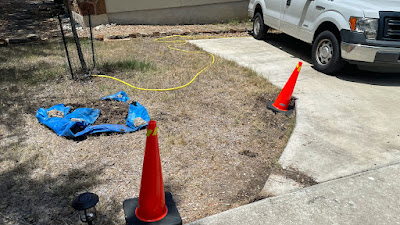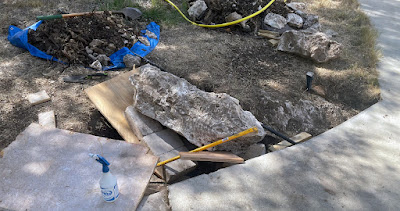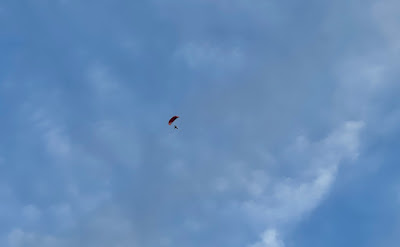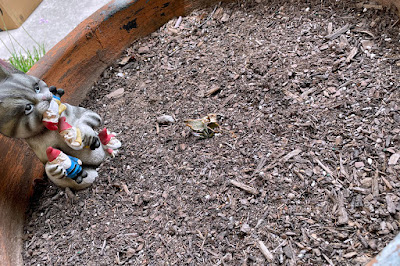Welcome back, friends, for the final Episode of AD 2022. I know it's been a few months since our last Episode, but believe me when I say there are good reasons for the delay in keeping y'all informed of our Texas House happenin's. And as promised in the previous Episode, the answers to the random trivia questions are all here, way down at the bottom of this Episode. So keep readin' through, or scroll all the way down yonder to check your answers.
Windows 22a
You shall recall from this Episode that our Texas House has about a bajillion windows, and we replaced about half of them in AD 2021. In order to avoid rising windows prices we decided to replace the other half this year (AD 2022).
Cute Cat Interlude
Plants Update
As usual, we planted some new plants earlier this year.
At the New House Blog we show our mistakes (maybe not all of them) as well as our triumphs. This is an example of the former. You will recall from this Episode that we installed a wall-mounted hose reel, and then installed the heaviest garden hose we could find. That turned out to be a mistake. We think that the weight of the hose was just too much for the poor hose reel, and it broke. We decided to replace it with a ground-based unit. So far it has not broken.
Windows 22b
Here you see a new window to the right of a new wall-mounted fan. Said fan helps with cooling and fumes reduction (when working with powerful epoxies and such-like).
Pavers 22a
The tarps are there to keep the dirt (and smaller rocks (and root bits)) under control and concentrated.
Happily, we were able to reconstruct this small boulder (with glue and dangerous epoxy, even) that we had to remove from the hole.
Happily, we were able to reconstruct this small boulder (with glue and dangerous epoxy, even) that we had to remove from the hole.
More boulders. The larger of the two in this picture was truly a challenge to excavate. We had to use pry bars, wood wedges, shovels, and several hours of labour to just pry it loose from its moorings.
To raise the largest boulders we had to rely on some of the oldest machines in existence - the lever, the inclined plane, and the stack of pavers. That is to say, we would pry up one end of the boulder, put a paver underneath, pry up the other end a bit, put a paver underneath, then repeat. In this we we were able to raise the Moa boulder to the surface and then roll it aside. It helps that we already had the pavers on-hand.
Windows 22c
Edgar is napping on top of Zorro, in front of one of our new windows.
Wildlife Update
Of course they didn't just stay in our yard 24-7, but they did seem to spend the majority of their time (as far as we could tell) on and around our property.
And I tell you what - those fawns really do blend into the grasses surprisingly well. It may be hard to make out, but there is a fawn right about in the center of this photo. I was in the back to turn on the water, and I almost walked right on top of this little dude before I saw him. I was able to reach the hose spigot, and the fawn didn't so much as flinch or acknowledge my presence.
At the time of this writing the little fawns have growed up and moved on to whatever deer do when they are growed up, and the family no longer calls our yard their home.
To prevent this escapement, we installed chicken wire over and in the Fillmore gap. So far he has not figured out a way around this.
And what would a paver project be without some PVC repair?
Paver base is going in. We decided to leave this boulder in situ. We have no idea just how large it is, so it seemed to make more sense to just carve the pavers to fit around it instead of trying to excavate it.
Paver base is in. Next comes the paver sand and then the pavers.
Finally, actual pavers in the hole! If you look closely you can see where we had to do a little sculpting on the bottoms of some of the pavers so they would fit around the one boulder we left in place.
More pavers go in, and soil backfill begins.
Pavers are in, soil is mostly backfilled, and the weather is nice.
Polymeric sand is in, and backfill is done. As of this writing, the grass is growing nicely in the backfilled area. But what of the boulders? Several of them now guard the entrance to our long driveway.
This new Christmas Cactus (Schlumbergera x Buckleyi) is sitting in front of one of our new windows. It (the cactus) is from a cutting supplied by DR in the RV. Thanks, DR. As of this writing it is thriving inside our Texas House.
Fillmore Fencing
Fillmore turns out to be somewhat of an escape artist. He has figured out that he can slip through a gap rail of our back porch, and from there he can jump down to the ground.
Pavers 22b
Paver base is going in. We decided to leave this boulder in situ. We have no idea just how large it is, so it seemed to make more sense to just carve the pavers to fit around it instead of trying to excavate it.
Paver base is in. Next comes the paver sand and then the pavers.
Finally, actual pavers in the hole! If you look closely you can see where we had to do a little sculpting on the bottoms of some of the pavers so they would fit around the one boulder we left in place.
More pavers go in, and soil backfill begins.
Pavers are in, soil is mostly backfilled, and the weather is nice.
Polymeric sand is in, and backfill is done. As of this writing, the grass is growing nicely in the backfilled area. But what of the boulders? Several of them now guard the entrance to our long driveway.
More Fillmore
Windows 22d
Answers:
As mentioned at the beginning of this Episode, here are the answers to the previous Episode's random trivia questions (in order).
The changing of the door locks; May 9, 2012; 33"X22"; Episode LXVIII; An oarfish; The trench of first Death Star; Three; Four; El Toro; Anton; 42" and 36"; Red; 105 F; Cuban sandwiches; 220 CFM; Four; Two of each
How many questions did you get
bIsh































































